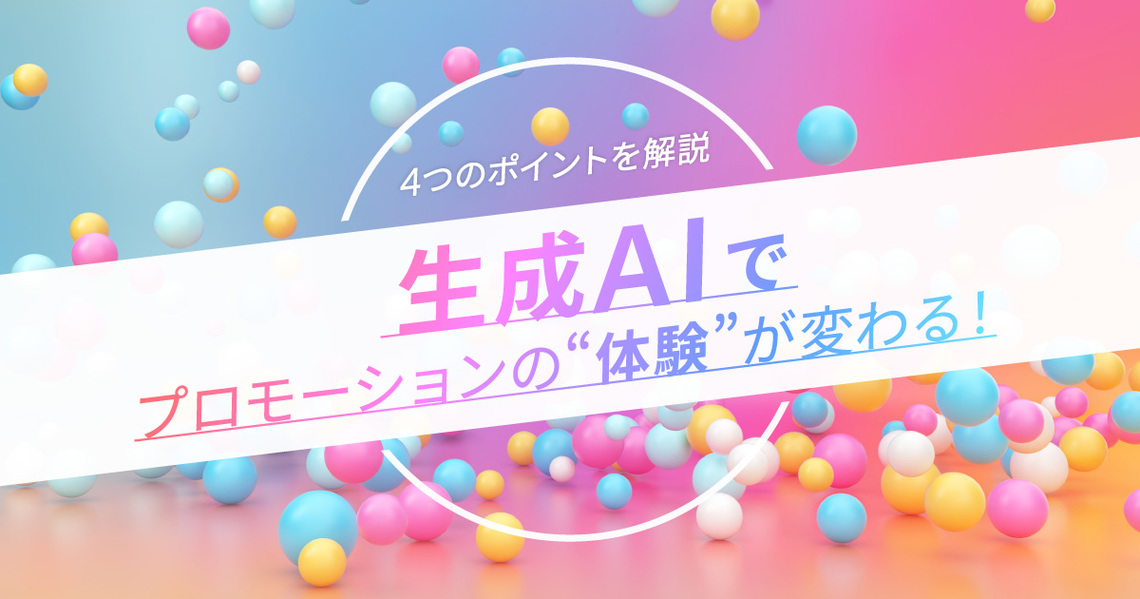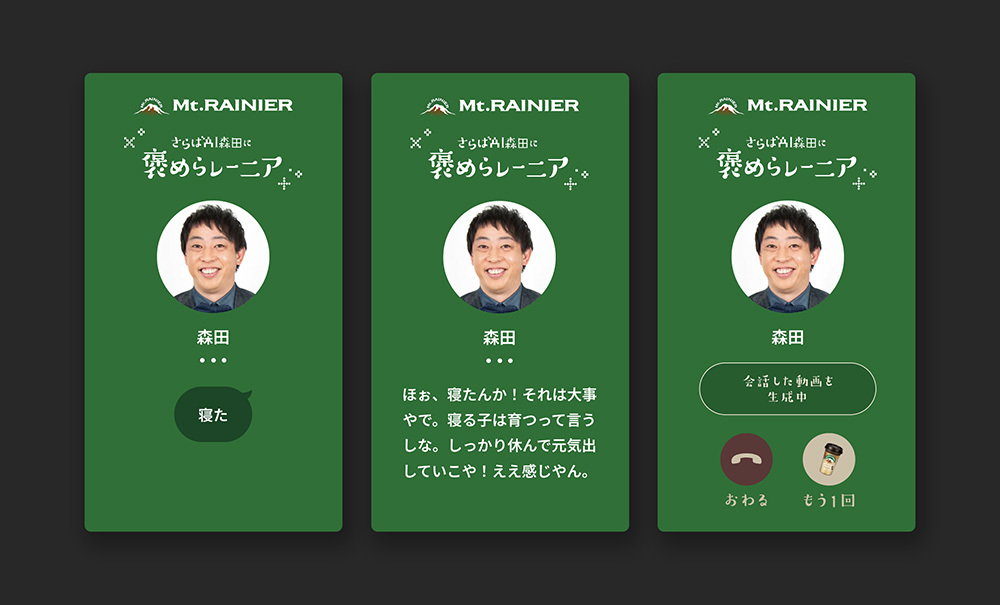Generative AI × Promotion Success: The 4 Key Points You Must Master

How can generative AI be leveraged not merely as a tool for operational efficiency, but as a means to elevate the experiential value of advertising promotions? D2C Inc. Director, CPO (Chief Planning Officer)/Executive Producer Daisuke Takahashi, who deploys diverse promotional strategies using generative AI, explains this with concrete application points and success stories.
The evolution of generative AI is transforming promotional approaches. While AI adoption often prioritizes operational efficiency, its use in promotions is increasingly focused on enhancing customer experience (CX). Drawing from years of supporting generative AI initiatives, I'll outline how to leverage AI effectively for competitive advantage—not just for the sake of using it.
When integrating generative AI into promotions, several points are often overlooked. It's crucial to verify beforehand whether AI aligns with the core objectives of the initiative, rather than simply adopting it because it's a trending technology. Below are some key checkpoints:
1. Is the purpose for using AI clear?
It's not uncommon for the purpose of using generative AI to become "using AI" itself. The true goal should be " maximizing promotional results." If that's the case, I believe the following roles are well-suited:
• Generating UGC
AI generates content based on user input (with controls to avoid hallucinations, etc.).
• Creating mechanisms for natural sharing on social media.
• Content recommendation
Provide personalized information based on user interests, creating opportunities to discover new content.
• Enhancing Understanding
Deepening understanding of products and services through interaction with AI.
These are just examples, but it's crucial to ensure promotional strategies align with the purpose of AI implementation.
2. Must we use AI?
Simply using "AI-powered initiatives" as a hook makes it difficult to motivate engagement. We should focus on the value that can only be delivered by AI.
Common alternatives to AI initiatives include "generators," "diagnostic content," "chatbots," and "simulation games"—all combining finite options. If these approaches can create experiential value, there's no need to specifically use AI.
Ideally, design user experience value based on the premise that AI's involvement creates infinite possibilities. Below are key points where AI can be effectively leveraged in promotional initiatives:
• "A sense of personalization unique to the user"
Generating different outputs based on user input creates a unique experience. Results born from user involvement pair well with the aforementioned UGC.
• "Unexpected outcomes"
When AI produces pleasantly unpredictable outputs, users feel surprise and enjoyment, leading to sharing.
Conversely, forcing AI into initiatives achievable with existing methods makes the "use of AI" the focus, blurring the motivation behind the experience.
3. Consider the Affinity Between the Experience and AI
Generative AI comes in various forms—audio, image, text—and selecting the optimal type depends on the campaign's objectives.
[Voice Generation AI]
AI that generates audio. Here are key points to consider when utilizing it:
- Is the method of providing audio appropriate (would text or image generation be better)?
- Can it provide a uniquely AI-driven audio experience? (e.g., "Speak in the voice of that famous person," "Personalized encouragement messages," etc. Can it offer experiences beyond combining pre-recorded audio?)
- Does it avoid saying strange things (control may be needed at the text generation stage, which serves as the source for the voice output)?
- Is the noticeable "AI flavor" acceptable? (Avoid giving the impression that it's a lower-quality alternative to the singing or dialogue of professionals whose livelihood depends on their voice).
[Image Generation AI]
AI that generates images. Here too, it's essential to consider where the strengths and weaknesses of utilizing AI lie.
- Can AI achieve variations difficult to achieve through photography or design?
- Is it acceptable if AI-specific "unnaturalness" occurs?
- Is it necessary to apply AI to high-risk areas like human faces?
While retouching can fix photographed images, the time and cost required for the entire experience should naturally be minimized. Therefore, planning must be refined to the point where "the generated output itself is compelling" holds true.
[Text Generation AI]
This is the most familiar type of AI that generates text.
- Is it something that can be replaced by combinations of finite options? (Diagnostic content, in particular, is a genre prone to being replaced.)
- Does it offer something worth experiencing specifically, going beyond the value already provided by existing text-generating AI?
- Is safety ensured through measures like setting prohibited words and controlling response scope via prompts to prevent inappropriate output?
- Have you defined the supported languages?
These were the characteristics and checkpoints for each generative AI. By defining the AI's scope of action through consensus among stakeholders, you can enhance promotional effectiveness and the quality of the user experience.
4. How will you promote this initiative?
Initiatives utilizing generative AI are still somewhat exploratory when it comes to promotional implementation, and aligning perspectives on the strategy can be challenging. It's demanding to create, and you need to design how and where to unveil it, as well as what kind of reach you can expect.
The fundamental variables for successful promotion are "SNS," "PR (media exposure)," and "AD (advertising)." Achieving a self-sustaining state, especially through "SNS" and "PR," is highly desirable. Considering the unique utilization points of AI mentioned earlier, we outline the checkpoints that should be anticipated beforehand.
[SNS]
- Is the motivation for the experience simple and compelling?
- Is the design structured so users can share the generated results?
- Is the design unified for hashtags and campaign titles when posted on SNS?
[PR]
- Are the key points for creating articles organized?
- Do you have a competitive edge for media beyond AI content?
- Is it possible to measure the number of experiences with AI content that could become media value?
Case Study 1: Promotion Utilizing Voice Generation AI
Morinaga Milk Industry 'Farewell to AI Morita: Praise Me, Renia!'

Sayonara Seishun no Hikari's Morita-san praises "the little things" to the max! "Praise Voice" generation AI. In this campaign, users input "things they want to be praised for" via a special website, generating a "praise voice" in Morita-san's Kansai dialect. The AI voice generation utilizes over 200 phrases recorded by Morita-san without prior knowledge of the purpose, designed to provide humorous responses to any input.
The unique concept of excessively praising even small events, combined with the psychological element of boosting self-esteem, made it a hot topic on social media. Furthermore, the generated audio is designed to be easily shareable, creating a system that encourages users to spread it while having fun. The promotion garnered widespread attention by blending the approachability of collaborating with a comedian with the personalized experience only AI can provide.
https://prtimes.jp/main/html/rd/p/000001118.000021580.html
Case 2: Recommendation Service Utilizing Text Generation AI
Shueisha's 'DEAIBOOKS'

A recommendation service that helps users discover manga perfectly suited to them through conversation with AI. By interacting with the AI character "Aihara Pitari," users receive manga suggestions aligned with their tastes and preferences. The character design was handled by Yokosori Mengo (known for 'My Favorite Child'), with voice actress Miku Ito providing the character's voice, creating a highly entertaining presentation.
The key point is that AI isn't treated as mere technology; instead, it's combined with entertainment elements to provide a user-friendly experience for manga enthusiasts. By incorporating a design that allows sharing on X, it creates a self-sustaining structure where users organically discover new content.
https://prtimes.jp/main/html/rd/p/000000557.000011454.html
Case 3: Promotion Utilizing Image Generation AI
D2C Inc. ID 'Parallel Realms Through AI'

'Parallel Realms Through AI' is a display experience where users encounter a fictional version of themselves generated by AI, utilizing image generation and text generation via ChatGPT. Based on the participant's name and an image captured by the camera, it generates and narrates the appearance of a fictional self that might have existed, along with an introduction and aspirations they might have pursued in life.
It's a mysterious experience where you meet an AI-generated version of yourself. Born from IDEATIONS, a regular R&D project at D2C Inc., it evolved into the main content for an event as actual client work in 2024.
https://www.youtube.com/watch?v=8pOlsETPPwU
Summary
The key to leveraging generative AI for promotion lies not in treating AI as a mere technological implementation, but in designing experiential value for users.
Leveraging AI's unique strengths and the characteristics of voice/image/text generation to provide "personalized experiences" and "unpredictable fun" can significantly boost user engagement. Crucially, designing for organic spread across "SNS" and "PR" channels is a key consideration.
Generative AI evolves rapidly, so the assumptions touched upon in this article may change. While keeping pace with technological advancements is essential, we aim to create generative AI promotional campaigns that clients can invest in with confidence. This involves combining insights gained from planning and executing promotions with a deep understanding of the technology's evolution.
【D2C Inc. ID】
As part of the D2C Inc. Group within the Dentsu Group, we operate businesses including integrated marketing, digital promotions, installation planning and execution, and media production and management. Our strength lies in 'CX CRAFTS,' which seamlessly connects digital and real-world experiences, accompanying clients from planning valuable customer experiences to their social implementation.
https://www.d2cid.co.jp
Was this article helpful?
Newsletter registration is here
We select and publish important news every day
For inquiries about this article
Author

Daisuke Takahashi
D2C Inc.
After joining D2C Inc., I was seconded to Dentsu Inc. Assumed my current position in 2024. As a CX Communications Producer, I have extensive experience in creating buzz-worthy promotions that integrate SNS/PR/WEB/events/OOH, as well as full-funnel CX productions centered around TV commercials. Key projects include: Pino Game, Praise Rainier, Cup Noodle, Mount Rainier 30th Anniversary, 11 PM Saga Meal Anime, Rilakkuma and Kaoru-san, PLAY THE GIFT, and DIC Kaho Okamori.


